US productivity growth significant during the third quarter of the year

In the April-June 2015 quarter, U.S. productivity seems to have followed a steady growth. The Labour Department said on Tuesday that workforce productivity has increased with a significant pace of 1.3 percent annual rate, despite being 1.1 percent down during the first quarter of the year.
Productivity defines the efficiency of workers and is measured in terms of output of goods produced and services rendered every hour. During the first quarter, the turndown was even higher than the previously estimated decline of around 3.1 percent. The second quarter appeared to cover up the slow growth rate and expanded the annual rate to 2.3 percent.
With productivity being slow and weak, companies have to hire more workers to enhance the output, which thereby holds back the wage growth. While in case of fast productivity, the number of workers for desirable output is less and the pay is more. As far as the pace of productivity is concerned, it has remained quite slow because of the recession period. This has resulted in the enhancement of productivity to just 0.3 percent in the past year, which was quite low as compared to the average annual rate of 2.2 percent.
Seeing the slow rate of productivity in 2012 and 2013, the growth rate seems significant in the April-June quarter of 2015. In fact, in 2013, the growth was almost a flat graph that showed the weakest productivity rate since 1982.
Even the labour cost didn’t show any vital growth in the first and second quarter of this year. In the first quarter, it was increased to 2.3 percent, while in the second quarter, it remained 0.5 percent more with a modest rise in the wages.
According to some economy experts , the improvement in software and other technological products should be measured correctly by the government’s statistics in order to lead to enhanced share of the economy in terms of manufacturing, agriculture and other fields of expertise.
Some economists specifically say that productivity increases when the companies understand how to take full advantage of the highly technical products and use the recent innovations effectively. Doing this would ensure the enhanced knowledge, ability and productivity of their workers and employees.
Contact the writer at feedback@ibtimes.com.au, or let us know what you think below.






